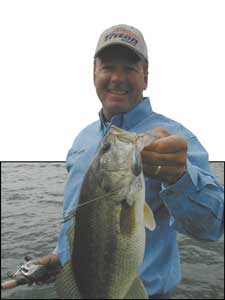
June can be kind of an “iffy” month for South Carolina bass anglers because the weather can change things so much. Last year, we had cool, rainy weather for the first part of June, but this year, we’ve had some really warm weather, and the bass could all be deep.So when I crank up my Evinrude E-Tec in the morning and leave the ramp, I want to head out and look for two things that are going to be happening — a good early morning topwater bite, then an offshore bite that will last the rest of the day. Don’t overlook that early morning/late afternoon topwater bite because it really can put you ahead.
I like to fish steeper banks durng June, banks that have a creek channel or maybe are close to the main-river channel so those fish can move up out of that deep water and feed easily. I like those steep kinds of places.
Normally, I’m going to fishing a big propeller bait, such as a Devil’s Horse or a War Eagle buzzbait, and I’m going to look for that topwater bite to last a good hour or two after daylight. I let the fish tell me how long the bite is going to last. If they keep biting, I’ll keep fishing. But if the bite dies after the first 30 minutes or so, I don’t try to force feed them.
That’s when I’ll back off and fish a crankbait, a Carolina rig or a big Texas-rigged worm, and that can really be a good bite, because traditionally, at our man-made lakes, the power companies will start to generate power at mid-morning, and that’s when you’ll do better at offshore spots.
I typically look for bass in 10 to 12, or even 14 feet of water. They’re still not as deep as they’re gonna get into July and August, but it’s offshore fishing.
I like to fish the main lake or some of the bigger creeks. I think the fish abandon a lot of the smaller feeder creeks by the middle of June.
When I fish an offshore spot, I’ll usually start with a crankbait because it’s a good bait to pinpoint fish, and you can cover more water with one. If I start catching fish with a crankbait and if falls off, that’s when I’m going to a Carolina rig or a Texas rig.
Fishing a Carolina rig, I’ll have 15- to 17-pound-test Trilene on my reel, and I’ll tie on a leader of 10- to 12-pound line. The later I go in the summer, the longer leader I’ll fish, either 3- or 4-feet long. Why? You’ve got water that’s clearing up, and I like to get my bait a good distance away from the hardware.
With a Carolina rig, I’ll fish a Gulp Swamp Crawler, which is a 6-inch, straight-tail worm, with a 3/0 Owner rigging hook.
If I fish a Texas rig, I’ll use a big 10-inch Berkley Power Worm with a 1/4-ounce slip sinker and a 4/0 Owner “J” hook or a wide-gap, offset hook.
During June I think a big worm seems to work much better than a small one. And you have to remember, I’m a tournament fisherman, so I’m fishing for five quality bites a day. You probably can catch more fish using a 6-inch curly-tail worm, but I have more confidence I can catch quality fish with a 10-inch worm.
When you start catching a few fish offshore, a big key is being able to identify where you’re catching ’em, whether it’s an inside or outside channel bend, a steep drop or a flat that drops off. Putting together a pattern is what’s going to make offshore fishing a success — or a bust if you don’t.
I do that two ways — with my paper map of the lake or with the maps loaded into my Lowrance GPS unit. I use the paper map at night when I can open it and really study and look at things. But normally when I’m in the boat, it’s a lot easier to look at the map on my X-26HD.
I can see the topographic lines, mark my spots and look for the same kinds of places where I’ve caught fish, to try and find a place to duplicate what I’m already doing.
It’s just a lot easier to concentrate on what you’re doing if you can watch the map that’s loaded on your depth-finder than have to unfold and fold up and keep putting your paper map in and out of your storage compartment.
Plus, whenever I’m running or fishing, I’m constantly looking at that depth-finder to see where I am and what I’m running over. And fishermen who are used to using a flasher unit, they quickly learn that on a unit with a screen, you’re most interested in what is just coming on the screen from the right, because that tells you what you’re over right now.
Fishing offshore isn’t as difficult as a lot of guys make it seem, especially those guys who love to fish shallow and aren’t comfortable fishing stuff they can’t see.
Being able to run a pattern offshore is just as important as running one in shallow water — it can be just as productive.
Davy Hite is a 40-year-old native of Saluda, S.C., who now resides in Ninety Six, S.C. He has fished professionally since 1993, when he qualified for his first Bassmasters Classic. He was the BASS Angler of the Year in 1997 and 2002, and he has won the 1999 Bassmasters Classic and the 1998 FLW Tour Championship. He is sponsored by Triton boats, Evinrude outboards, All-Star rods, Pfleuger reels, Pure Fishing (Berkeley), Owner hooks and Solar-Bat sunglasses.




Be the first to comment